|
Bullpup rifles and shotguns have always
fascinated me. The design makes a lot of sense, moving the
action into the buttstock, effectively shortening the overall
length of the weapon without shortening the barrel. For me,
being a left-handed shooter, most bullpup firearms have been
unusable. Simply moving the action to the buttstock in most
designs leaves the ejection port pretty close to a left-handed
shooters ear, making the design essentially a single shot for
me, as a hot empty cartridge case ejected into the ear canal
makes concentrating upon a follow-up shot difficult at best.
There are a couple of designs that allow the shooter to switch
the ejection to the left side, another which ejects out the
front, and one that ejects out the bottom. However, none of
these have been chambered for the 7.62x51 NATO (.308 Winchester)
cartridge, until now.
It has
been almost three years now since I was first shown Kel-Tecís
RFB carbine back in early 2007. RFB stands for: Rifle,
Forward-ejecting Bullpup. It has taken awhile to get the design
perfected and to get the rifle into production, but they have
been in production for a few months now, and I finally have one
laying across my lap as I type this. I have been shooting this
rifle for a couple weeks now by day, and studying its design by
night. I have spent hours just looking over the schematic
drawings in the manual, and staring at the pictures of how the
carbine operates. The action is a short-stroke gas piston with a
tilting-block action. Other than having a barrel with a rifled
bore and feeding from a box magazine, nothing about this rifle
is conventional.
The barrel length on this RFB carbine
measures eighteen inches, and the muzzle is threaded 5/8x24
threads-per-inch, so that it will readily accept muzzle brakes,
flash suppressors, and sound suppressors. The carbine is
equipped with a closed-bottom birdcage style flash suppressor.
The barrel is rifled one turn in 11.25 inches, and has six
grooves. A twenty-four inch barreled model will be offered in
the future. The RFB uses commonly-available metric pattern FAL
surplus magazines, and comes supplied with one twenty-round mag.
The magazine slides up straight from the bottom, with no tilting
necessary to slam it home with the bolt locked open. There are
ambidextrous bolt release levers at the rear of the magazine
housing on either side, and an ambidextrous magazine release at
the rear of the magazine housing. The paddle-type mag release is
very easy to use. The safety is also ambidextrous, with levers
on either side at the top of the pistol grip. The charging
handle pulls to the rear and is released to chamber a cartridge
from the magazine, and can be easily and quickly switched to
either side, as the operator prefers. This RFB carbine is a true
fully-ambidextrous design. Nothing is compromised for
left-handed shooters, and the rifle works just as well for a
left-hander as for a right-handed shooter. Thanks, Kel-Tec!
The barrel of the RFB is made from 4140
ordnance steel, and has a chrome-lined bore and chamber.
The bolt, receiver, and gas system are also made of 4140 steel,
and the internal surfaces of the gas system are chrome plated as
well to resist wear and corrosion. The bolt carrier and upper
cover are made of stamped 4130 sheet steel. The grip and hand
guard are made of made of a high-tech polymer, and are textured
for a positive grip. The hand guard has an integral hand-stop at
the lower front to prevent the support hand from sliding forward
and touching the hot barrel. Machined into the barrel, just
forward of the gas block is a threaded area about 1.125 inches
in diameter, with interrupted threads. I know of nothing that is
built to attach to this, but was told by Kel-Tec personnel that
it is for a future accessory.
The gas piston system has an adjustable
regulator which Kel-Tec calls the gas restrictor cap. The device
adjusts the amount of gas that is delivered to the piston, to
compensate for the ammunition, weather conditions, and other
variables to reliably operate the action.
The RFB has no mechanical sights, but wears a
nine and three-quarters inch long 1913 Picatinny rail atop the
rifle for the mounting of optical sights. It is the ideal height
to mount a good rifle scope or dot sight, such as a Trijicon
Reflex. For a medium to long range battle sight, a Trijicon
ACOG would be perfect, or for target work, any good quality
target scope such as a Leupold Mark 4 fits very well, without
adding too much bulk to the rifle.
This compact design results in an overall
length of only twenty seven and one-half inches including the
detachable flash suppressor, and an empty weight of eight
pounds, nine ounces on my scale. The length of pull is fourteen
inches. The very handy overall length is almost a full foot
shorter than my LRT-SASS with an equal-length barrel. The RFB is
also lighter, and balances very well, right at the pistol grip.
The RFB carbine would serve handily where a powerful but compact
weapon is needed in tight quarters.
At first, I was a bit intimidated about
taking this RFB apart to examine the internals, as I have seen
nothing quite like this before, but after doing so, found that
it is very easy to disassemble for cleaning and maintenance, and
nothing more than the nose of a bullet is needed to fully strip
this carbine. There are a couple of disassembly pins in the
rear, and another in the front, to access parts and to remove
the bolt and carrier for access to the barrel breech for
cleaning. The gas piston system is easy to clean, and is a very
simple and reliable design. A small amount of powder gas is bled
off through a hole in the bore, flows through the gas block, and
the short-stroke piston smacks the bolt carrier directly, moving
it rearward to extract the fired case and chamber a fresh round
from the box magazine. The empty cartridge case is not ejected
with the rearward movement of the bolt and carrier, but is held
by the extractors until the bolt is moving forward chambering a
cartridge. At that time, the empty case is tilted slightly
upward, and is released by the extractors into the ejection
chute as the bolt closes on the freshly-chambered round. It is
an ingenious design, like nothing that I have ever seen before.
The empty cases then slide forward, out through a hole in the
gas block.
After getting a good peek inside and taking a
few pictures, I was anxious to get this rifle into action. It
has been a long time coming. I gathered a variety of .308 and
7.62x51 ammo, and mounted a Leupold Mark 4 scope for accuracy
and function testing. Ammo consisted of military NATO spec 147
grain ball and purple-tip cartridges, commercial .308 hunting
ammo, and Buffalo Bore Sniper and Federal Gold Medal Match
hollowpoint target ammo. With every type tested, reliability was
one hundred percent. Every round fed, fired, and ejected
perfectly, and the bolt always locked open on an empty magazine.
Accuracy varied from good to superb, depending upon the ammo
chosen. Federal Gold Medal 168 grain hollowpoint was by far the
most accurate ammunition tested in this RFB carbine, grouping
reliably under three-quarters of an inch for three shots at one
hundred yards. The military ball ammo grouped closer to
two inches. Any rifle is only as accurate as the ammo fed it,
and the ball ammo was from broken-down machine gun belts. It was
cheap and perfectly reliable, but better stuff is needed for
good accuracy. Felt recoil was mild, with no pain to the
shoulder after extensive firing sessions. With the location of
the box magazine, shooting from a conventional benchrest for
accuracy is a problem. However, the RFB worked very well in the Target
Shooting, Inc. rifle rest, allowing me to see just how
accurately the RFB could shoot. While most bullpup rifles have
heavy, long trigger pulls, the RFB does not. The Kel-Tec RFB has
absolutely the best trigger pull that I have ever felt on a
bullpup rifle. The release is crisp, and while measuring right
at six pounds on my trigger pull gauge, it felt lighter and was
easy to use, making target work very enjoyable.
Kel-Tec is a very innovative company. The
folks there conceive and produce firearms that are unlike other
designs on the market. They do not simply slap their label onto
existing designs, but produce truly unique firearms which fill
niches that need filling. I have long seen a real need for a
reliable, easy to carry .22 Magnum auto pistol, and Kel-Tec has
one in the works right now. It will weigh less than fourteen
ounces, and have a thirty-shot magazine! Called the PMR-30, I
should get to handle a prototype at SHOT in about three weeks.
If it is as good as I think it will be, I gotta have one! Maybe
two. The hard part will be the waiting.
The Kel-Tec RFB is a handy, reliable, and
accurate bullpup rifle that packs the full power of the
7.62x51mm NATO cartridge. It can fire any 7.62x51 or .308
Winchester ammunition reliably. The design is innovative, yet
simple enough to work dependably. As of this writing, the retail
price is $1880 US, and they are bringing that much, as demand is
still outrunning the supply. However, it is a fine carbine, and
there is nothing else like it on the market. It is a quality
design, built with quality materials, and built in the USA. I
like it.
For more information on this and other
Kel-Tec products, go to www.kel-tec-cnc.com.
For the location of a Kel-Tec dealer near
you, click on the DEALER LOCATOR at www.lipseys.com.
To order the RFB online, go to www.galleryofguns.com.
Jeff
Quinn
| For a list of dealers where you can
buy this gun, go to: |
|
To buy this gun online, go to: |
 |
|
 |
|

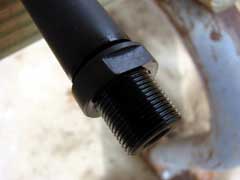
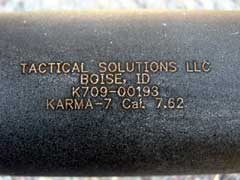
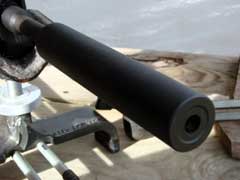
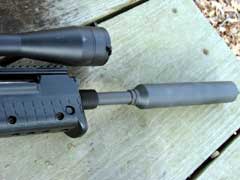
Author also fired the RFB with a Tactical Solutions
sound suppressor attached. Reliability with the can attached
was flawless, and the sound signature greatly reduced.
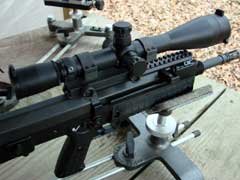
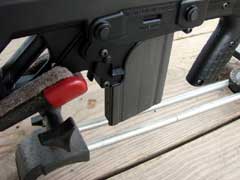
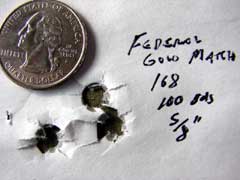
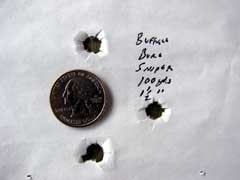
Accuracy testing was done using a Model
500 rifle rest from Target Shooting, Inc.
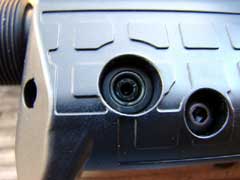
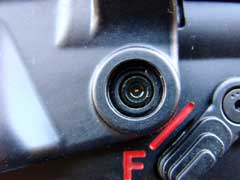
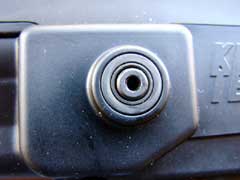
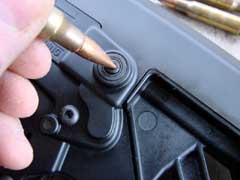
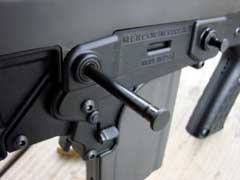
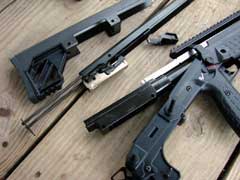
Disassembly pins.
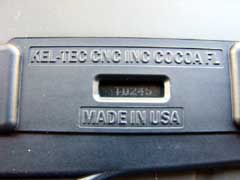
|
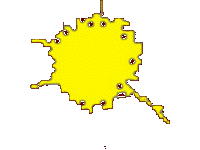  
Got something to say about this article?
Want to agree (or disagree) with it? Click the following link to
go to the GUNBlast Feedback Page.
|
|
Click pictures for a larger version.
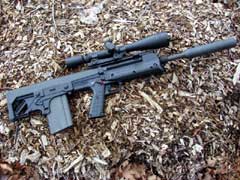
Kel-Tec's RFB 7.62x51mm bullpup carbine.
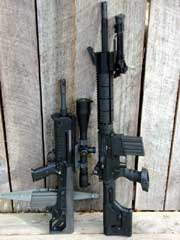
The RFB (left) and DPMS SASS (right) have
equal-length barrels.
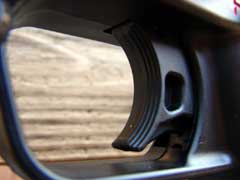
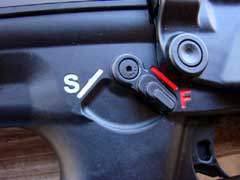
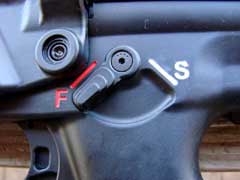
Ambidextrous safety levers.
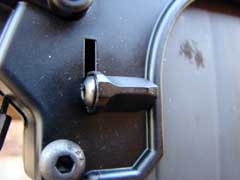
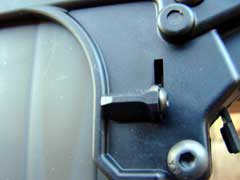
Ambidextrous bolt release levers.
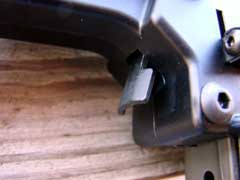
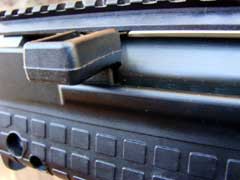
Magazine release (top) is also ambidextrous, and
charging handle (bottom) is reversible.
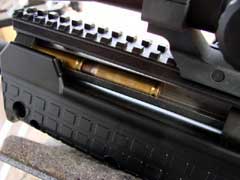
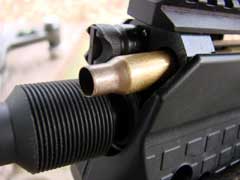
Empty cases slide along the chute, exiting through a
hole in the gas block.
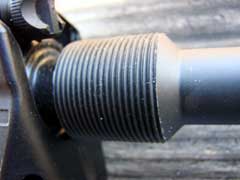
Threaded barrel section for future accessory.
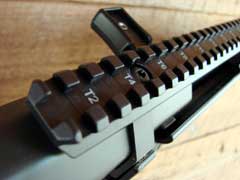
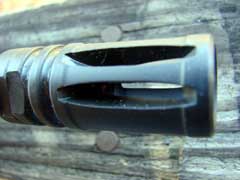
Closed-bottom birdcage flash hider.
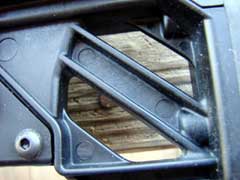
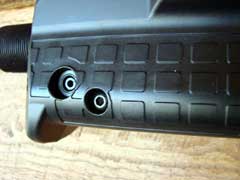
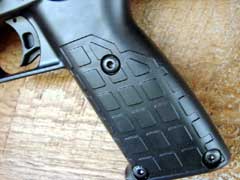
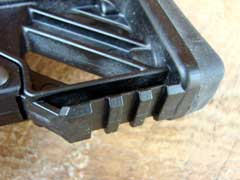
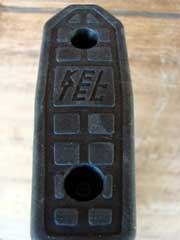
Stock has a section of Picatinny rail at the toe
(top), and a synthetic rubber butt pad (bottom).
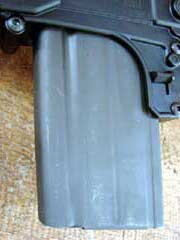
The RFB uses commonly-available metric pattern FAL
magazines.
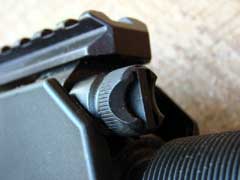
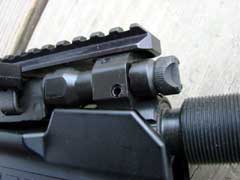
Gas adjustment cap and piston.
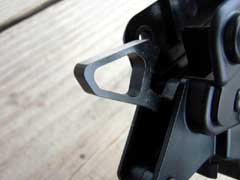
Hammer.
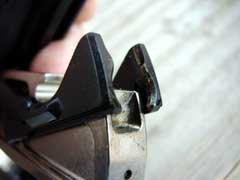
Extractors.
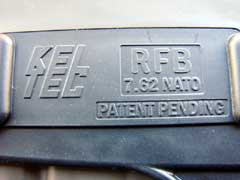
|
![]()